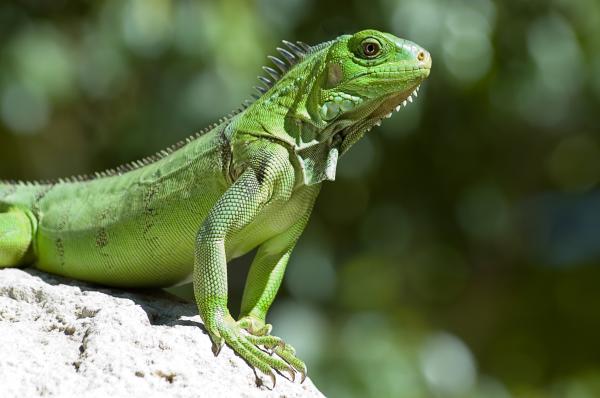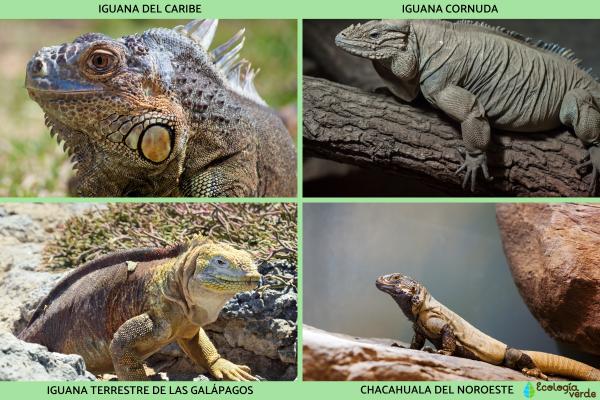Iguanas, often called “living little dinosaurs” for their appearance, are reptiles belonging to the family Iguanidae. Native to the tropical regions of the Americas and the Caribbean, iguanas have been consumed by humans for their meat and eggs since pre-Columbian times and are also widely sold as pets. But does this human pressure put iguanas at risk of extinction? This article explores the conservation status of different iguana species, the major threats they face, and what can be done to protect them.

The Iguanidae family includes several species, each with a unique conservation status. Here are five well-known iguana species and their current situation:
The most common iguana, spending most of its life in trees, with strong claws and tail. Males are distinguished by a long dorsal crest. Despite years of exploitation for meat, skin, and the pet trade, the green iguana is not currently endangered. According to the IUCN (International Union for Conservation of Nature), it is listed as Least Concern.
Found in the Lesser Antilles, this species is similar in appearance to the green iguana but differs in morphology and coloration. The Caribbean iguana is now classified as Critically Endangered due to competition from invasive species, predation, road accidents, and habitat loss.
Endemic to Hispaniola (Dominican Republic and Haiti), this iguana is named for the three horn-like projections on its snout. Habitat destruction caused by tourism, agriculture, and mining has led to its Endangered status, with populations declining steadily.
Exclusive to the Galápagos Islands, this species inhabits dry areas with low shrubs and cacti. It is classified as Vulnerable due to threats like habitat degradation and invasive species, with populations declining.
Found in the deserts of the southwestern United States and northern Mexico, chuckwallas are highly heat-tolerant. This species is considered Least Concern, with stable populations and no major current threats.

Although not all iguanas are endangered, many face significant threats that put their survival at risk:
Illegal Hunting: Many iguana species are hunted for their meat, eggs, and skins, with some individuals trafficked for the exotic pet market.
Pet Trade: Iguanas are often captured and sold as pets, but many die in captivity due to improper care and diet, stress, or disease.
Habitat Loss and Fragmentation: Urban development, agriculture, and tourism reduce and divide their natural habitats, making survival difficult.
Invasive Species: Introduced predators (such as cats, dogs, and rats) and competing species threaten iguanas by preying on them or outcompeting them for resources.
Climate Change: Rising global temperatures threaten all reptiles, including iguanas, as many species’ sex is determined by incubation temperature. Climate change can disrupt their reproduction and survival.
Despite the many challenges facing iguanas, several effective conservation measures can help:
Establish Conservation Projects: Implement scientific conservation plans, such as habitat restoration, captive breeding, and wild population monitoring.
Strengthen Laws and Enforcement: Advocate for stronger wildlife protection laws and ensure strict enforcement to curb illegal hunting and trade.
Raise Public Awareness: Launch environmental education campaigns to inform people about iguana conservation, discourage the purchase of wild-caught pets, and promote responsible behavior.
Say No to Wild Pets: Avoid keeping wild animals as pets. Buying iguanas from illegal markets supports poaching and harms wild populations.
Promote International Cooperation: Support cross-border conservation initiatives and research to protect widespread or migratory iguana species.
Most iguana species are not yet considered globally endangered, but some unique species—like the Caribbean iguana and rhinoceros iguana—are at serious risk of extinction. The survival of iguanas depends on collective action, including conservation, legislation, public education, and responsible wildlife practices. To learn more about iguanas and endangered species, follow our wildlife and animal encyclopedia!
Bibliography
International Union for Conservation of Nature Red Lists. Website: https://www.iucnredlist.org/
animal tags: Iguanas
We created this article in conjunction with AI technology, then made sure it was fact-checked and edited by a Animals Top editor.